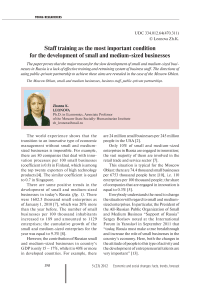Staff training as the most important condition for the development of small and medium-sized businesses
Автор: Leonova Zhanna Konstantinovna
Журнал: Economic and Social Changes: Facts, Trends, Forecast @volnc-esc-en
Рубрика: Young researchers
Статья в выпуске: 5 (23) т.5, 2012 года.
Бесплатный доступ
The paper proves that the major reason for the slow development of small and medium-sized businesses in Russia is a lack of effective training and retraining system of business staff. The directions of using public-private partnership to achieve these aims are revealed in the case of the Moscow Oblast.
Moscow oblast, small and medium businesses, business staff, public-private partnerships
Короткий адрес: https://sciup.org/147223390
IDR: 147223390 | УДК: 334.012.64(470.311)
Текст научной статьи Staff training as the most important condition for the development of small and medium-sized businesses
The world experience shows that the transition to an innovative type of economic management without small and mediumsized businesses is impossible. For example, there are 80 companies that deal with innovation processes per 100 small businesses (coefficient is 0.8) in Finland, which is among the top twenty exporters of high technology products [4]. The similar coefficient is equal to 0.7 in Singapore.
There are some positive trends in the development of small and medium-sized businesses in today’s Russia (fig. 1) . There were 1602.5 thousand small enterprises as of January 1, 2010 [7], which was 20% more than the year before. The number of small businesses per 100 thousand inhabitants increased to 189 and amounted to 1129 enterprises; the cumulative growth of the small and medium-sized enterprises for the year was equal to 9.3% [8].
However, the contribution of Russian small and medium-sized businesses in country’s GDP is only 15 – 17%, while it is 40% or more in developed countries. For example, there are 24 million small businesses per 245 million people in the USA [2].
Only 10% of small and medium-sized enterprises in Russia are engaged in innovation; the vast majority of them are involved in the retail trade and service sector [7].
This situation is typical for the Moscow Oblast: there are 74.4 thousand small businesses per 6753 thousand people here [10], i.e. 110 enterprises per 100 thousand people; the share of companies that are engaged in innovation is equal to 0.3% [5].
Everybody understands the need to change the situation with regard to small and mediumsized enterprises. In particular, the President of the All-Russian Public Organization of Small and Medium Business “Support of Russia” Sergey Borisov noted at the International Forum in Yaroslavl in September 2011 that “today, Russia must make a true breakthrough and increase the role of small businesses in the country’s economy. Here, both the changes in the attitude of people to this type of activity and the development of entrepreneurial talents are very important” [13].
Figure 1. The number of small businesses in 1999 – 2009 (including micro-enterprises, without medium-sized businesses and individual entrepreneurs) [6]
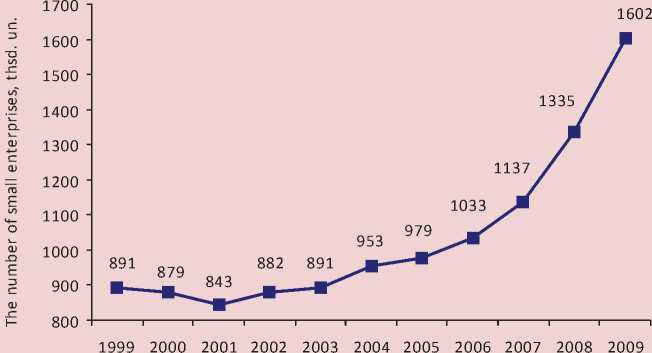
The causes of slow development of small and medium-sized businesses are determined by the whole range of factors. The most important of them is a lack of effective system of entrepreneurial staff training and retraining.
This position was confirmed during our entrepreneurs opinion poll in the SouthEastern region of the Moscow Oblast. 510 managers of small and medium-sized enterprises took part in the poll.
The main method of research was based on a personal quantitative structured interview.
The average number of employees per one enterprise in the study is 17 persons, including 14 permanent and 3 temporary employees; about half of the staff consists of qualified and unskilled workers. At the same time, there are no human resource specialists in the majority of small and medium-sized enterprises; general director or his/her deputies act as these specialists.
The sampling structure of this poll is presented in tables 1, 2 and figure 2 .
The study shows that there is a serious staff deficit in small and medium-sized business (fig. 3), especially among qualified (41%) and unskilled (8%) workers. A lack of qualified and service employees makes itself felt most strongly in manufacturing and constructing small and medium-sized businesses, as well as in the retail industry.
Secondly, managers in selling are in demand. This need has been pointed out by 17% of the heads of small enterprises.
All the respondents are interested in additional staff training (tab. 3) . The directors of construction (4.1 out of 7 points) and manufacturing (3.7 points) companies need for the assistance in this matter. The businesses that operate less than three years are troubled by this problem most of all (5.2 points). The attitude of respondents to the problem of non-government support in solving staffing problems has been also estimated.
There is a high potential demand for the programmes in economics and business finance – 36% of respondents; the demand for staff training programmes is in the second place – 33% of respondents. The demand for the programmes in innovative technologies accounts for 24%, law – 22%, selling – 21%, management – 19%, information technologies – 18% (fig. 4) .
Table 1. Sampling structure of entrepreneurs opinion poll in the South-Eastern region of the Moscow Oblast
|
Respondent’s position |
The share of group, in % |
Age of respondents, years |
Age of an enterprise, years |
|
Founder / owner |
11 |
25 – 34 |
2 and less |
|
General Director |
51 |
35 – 44 |
3 – 5 |
|
Commercial / Finance Director |
22 |
45 – 54 |
6 – 10 |
|
Human resources manager |
16 |
Over 54 |
Over 10 |
|
The table has been made by the author according to the results of the study. |
|||
Table 2. Annual turnover of the enterprises, managers of which took part in interviewing
|
Groups according to turnover |
The share of group, in % |
|
Less than 250 thsd. rub. |
12 |
|
250 – 1 250 thsd. rub. |
15 |
|
1 250 – 5 000 thsd. rub. |
26 |
|
5 000 – 25 000 thsd. rub. |
32 |
|
More than 25 000 thsd. rub. |
15 |
|
The table has been made by the author according to the results of the study. |
|
Figure 2. Activities of the enterprises which took part in the poll
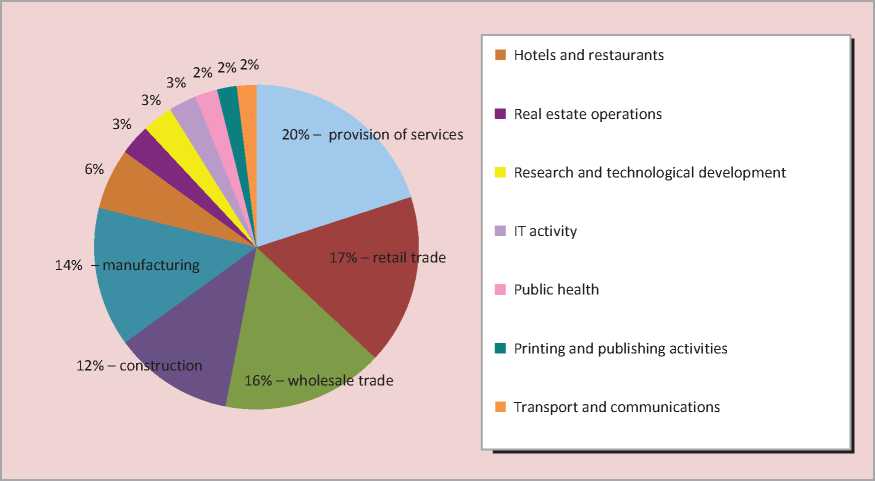
The data of the managers opinion poll of small and medium-sized businesses in the South-Eastern region of the Moscow Oblast also shows that there is a demand for seminars and conferences to exchange experiences and workshops for HR managers. However, retail (3.4 points) and construction (3.3 points) companies are more open in this matter. And
the managers of all the companies regardless of the period of companies’ operating have expressed their willingness to take part in the training seminars.
The problem of financial support for organizing and conducting training and retraining the staff of small and medium-sized businesses was being discussed during the poll.
Table 3. Attitude to staffing problems (response to the question: “What forms of state support does your company need to solve staffing problems?”; in points: 1 – it isn’t important, 7 – maximum value)*
|
Form of state support |
Types of activity of an enterprise |
Age of an enterprise |
|||||||
|
Ъ 2 1 ~ |
S |
ОО |
о |
5 |
S ОО 5 |
ОО |
1 |
о |
|
|
Compensation for the cost of professional training |
4.5 |
4.4 |
4.6 |
5.3 |
4.4 |
5 |
5.1 |
4.9 |
4.1 |
|
Assistance in staff recruiting |
3.2 |
2.7 |
2.9 |
4.1 |
3.7 |
5.2 |
3.8 |
2.8 |
3.2 |
|
Consultancy in staffing |
3.1 |
2.9 |
2.8 |
3.8 |
3.9 |
2.9 |
3.2 |
3.8 |
3.1 |
|
Renewal of staffing regulatory system |
2.6 |
2.6 |
3.6 |
2.7 |
3.8 |
2.8 |
2.9 |
3.7 |
3 |
|
Seminars and conferences to exchange experience |
2.6 |
3.6 |
2.7 |
3.8 |
2.8 |
3.1 |
2.9 |
2.9 |
3 |
|
Seminars for human resource managers |
3 |
3.2 |
2.7 |
2.8 |
2.3 |
2.9 |
3.4 |
2.8 |
2.6 |
* The table has been made by the author according to the results of the study.
Figure 3. The most popular professions that have been identified during the poll (response to the question, “What specialists does your company need most of all?”; in % of the heads of small enterprises who took part in the poll)
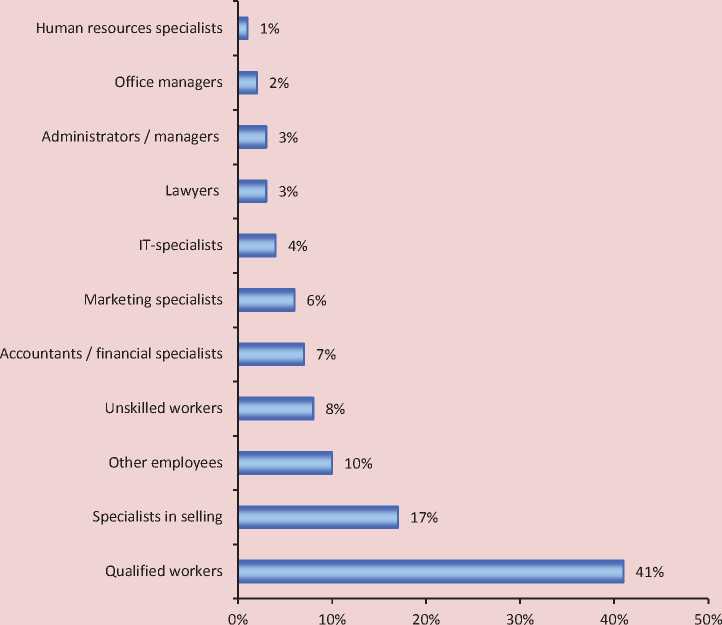
Figure 4. Staff training programmes that are in demand among small and medium-sized businesses (in % to the number of respondents)
Staff training programmes that are in demand
Other programmes
Innovation technologies
Information technologies
Marketing, advertising, PR
Operation of business / management
Selling
Law
Professional training of workers
Business economics and corporate budgeting
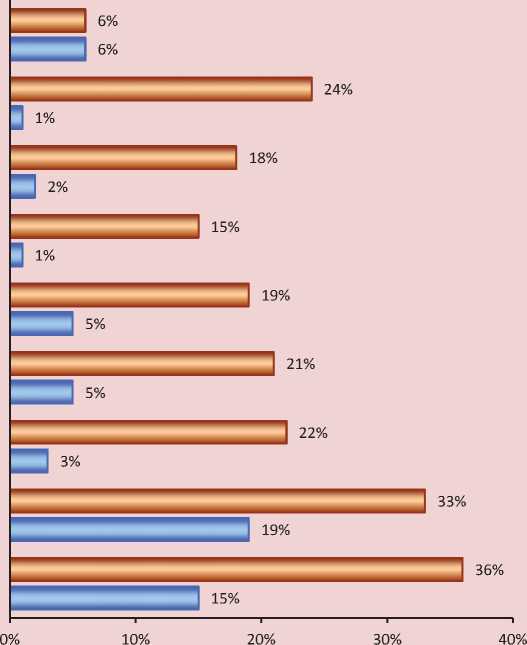
□Completed training programmes
□ Popular training programmes
On average, one small enterprise situated near Moscow spends 34.5 thousand rubles per year to train all the employees, i.e. 2.5 thousand rubles per one employee annually (fig. 5) .
With the state co-financing of entrepreneurial staff training and retraining programmes, the usefulness of which was stressed by all the respondents, companies are ready to increase their staff training expenses (fig. 6) .
Everyone expressed the willingness to increase funding for the programmes up to 12.5% on average answering the question “How much is your company ready to spend for staff trai-ning per year if the government adds the same sum of money?”
According to managers of small and medium-sized businesses, increasing the state financial support for training programmes will
Figure 5. Staff training expenses, rub.
Question: How much has your company spent for staff training or retraining over recent 12 months? Rub.
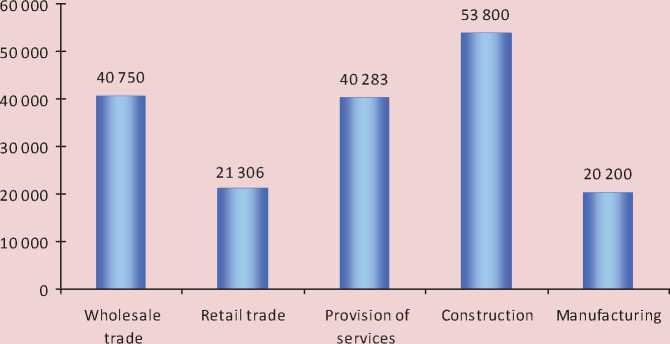
Figure 6. The potential volume of training expenses, rub.
Question: How much is your company ready to spend for staff training per year if the government adds the same sum of money? Rub.
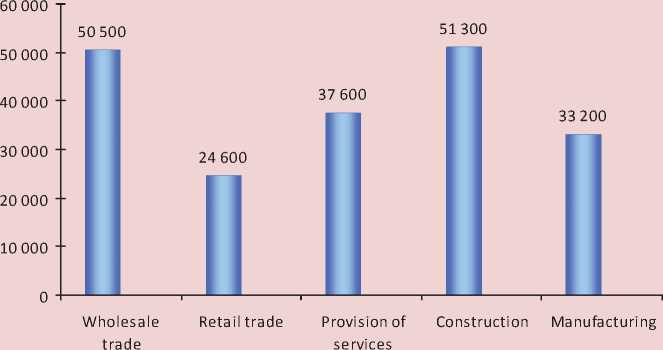
allow the state to take part actively in the development of support system for small and medium-sized business.
Impact of a financial factor is also confirmed by a survey conducted by the Executive Portal and the International Institute of Management LINK: 50% of respondents who have a desire to train and receive training, do not take part in the business educational programmes due to a lack of finance [1].
Indeed, the system of business education in Russia is concentrated in large cities. And the average cost of training varies from 3,000 to 13,500 U.S. dollars [11].
|
Figure 7. Mechanisms of public-private partnership [3] Mechanism of Public-Private Partnership |
||||
|
Contractual form |
Institutional form |
|||
|
L |
—________L ■ |
|||
|
Joint financing of educational programmes |
Establishment of business schools (founders – subjects of the private sector with government agencies) |
|||
|
Educational loans for small and medium-sized businesses |
||||
|
Establishment of corporate universities – nonprofit partnerships |
||||
|
Participation of the private sector in the educational process |
||||
|
Establishment of research centers in the form of legal entities |
||||
|
Joint conferences and seminars |
||||
|
Establishment of charitable foundations by the subjects of the private sector (nonprofit organizations) |
||||
|
Students’ practical training in the company of a business partner |
||||
|
Grant and scholarship business support for students and teachers |
Forming the boards of guardians |
|||
|
Involvement of small and medium-sized businesses in endowment funds |
||||
|
Support and modernization of universities’ infrastructure |
||||
|
Joint research projects and experimental developments |
Forming innovation clusters that involve small and medium-sized businesses |
|||
This study allows us to draw a conclusion about the insolvency of such an element of economic relations as the entrepreneurial staff training system. However, small and mediumsized businesses are able to respond quickly to the changes in the information field due to their isolation.
Therefore, using the mechanisms of publicprivate partnership will enhance the pro-cess of effective staff training for entrepreneurship.
The cooperation between the participants of today’s market requires a higher level of strategic thinking of the managers of small and medium-sized enterprises.
Список литературы Staff training as the most important condition for the development of small and medium-sized businesses
- Business Education. Commercial Director. 2011. No. 9.
- Report of Dmitry Medvedev at the meeting of the State Council of Russia, March 27, 2008. Available at: http:www.rost.ru
- Public-private partnerships in education. Ed. by O.P. Molchanov, A.Ya. Livshin. Moscow: KDU, 2009. 242 p.
- Innovative development -basis of the modernization of Russia’s economy: National Report. Moscow: IMEMO RAS, HSE, 2008. 168 p.
- Information-analytical collection “Innovation activity in the Moscow Oblast”. Available at: http://me.mosreg.ru/inov_razv/1024.html
- Leonova Zh. K Innovative small business as a strategic resource of national security. In: National interests: priorities and security. Moscow: Publishing House “Finance and Credit”, 2011. No. 6.
- Small and medium-sized businesses in Russia. 2010: Stat. Coll. Rosstat. Moscow, 2010. 172 p.
- Small business in Russia in 2009 and in the first half of 2010: the impact of government support on the sector: proceedings of the V Interregional round-table discussion “Financing of small and medium-sized enterprises in the Ural-West Siberian region”. Ekaterinburg, 2010.
- Proceedings of the round-table discussion at the St. Petersburg International Economic Forum. Available at: http://www.kommersant.ru/doc/1661216
- Regions of Russia. Socio-economic indicators. 2010: Stat. Coll. Rosstat. Moscow, 2010. 996 p.
- Russian Statistical Yearbook. 2010: Stat. Coll. Rosstat. Moscow, 2010. 813 p.
- Demand trends in business education. Available at: http://new.begingroup.com/
- Yaroslavl Forum: experts are making forecast. Available at: http://www.gpf-yaroslavl.ru/

